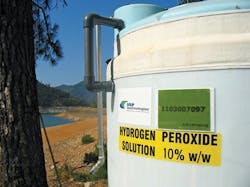Refinery Wastewater: Refining Processes
About the author: Michael Fagan is director, industrial business and technology development for USP Technologies. Fagan can be reached at [email protected] or 908.362.1000.
In the summer of 2010, a large refinery complex in the Northeast was facing a two- to three-month maintenance outage on one of two aeration basins in its activated sludge wastewater treatment system. During the outage, all of the refinery wastewater would need to be routed through the one remaining aeration basin. Because the refinery periodically had difficulty maintaining dissolved oxygen (DO) levels with both aeration basins in service, they needed a temporary and non-capital means to provide the biological treatment system with supplemental DO during the maintenance outage.
Hydrogen peroxide (H2O2) has been used as a source of supplemental DO in activated sludge treatment systems for decades. In the aeration basin mixed liquor, H2O2 converts to DO according to the following reaction: 2 H2O2→O2 + 2 H2O
This decomposition to DO occurs very rapidly due to the catalytic effect of enzymes (e.g., catalase) present in all activated sludge mixed liquors, and thus provides an immediate source of DO to the biomass. Because H2O2 is a liquid, and infinitely soluble in water, the amount of DO provided is not limited by mass transfer of oxygen from the gas phase to the liquid, as is the case with mechanical aeration.
Dosing Solution
When the maintenance outage was initiated and wastewater flow was diverted to the remaining aeration basin, DO levels rapidly dropped from the target range of 2 to 3 mg/L to near zero (0.1 to 0.2 mg/L). Dosing of 27% H2O2 into the effluent of the dissolved air floatation unit just upstream of the aeration basin was started to offset this unacceptable drop in DO. Within a matter of hours, a measurable DO increase was observed and continued to trend upward throughout the day.
Within 24 hours of starting H2O2 dosing, the DO levels in the aeration basin were back in the 1 to 2 mg/L range, and within 48 hours had reached the refinery targeted 2 to 3 mg/L range. Dosing of 27% H2O2 was continued throughout the maintenance outage and maintained the DO levels required for effective biochemical oxygen demand (BOD) removal and nitrification (ammonia removal).
During the outage, the refinery experienced no filamentous bulking episodes. This translated to good clarifier settling, which historically had been a concern when treatment system DOs were experienced.
Scope of Supply
The refinery contracted USP Technologies to provide to provide a supply scope that included:
- 27% refinery-grade H2O2;
- Engineered storage and dosing equipment system;
- Equipment installation and maintenance services during the project;
- Remote monitoring and product inventory management; and
- Applications services, including dose rate optimization and process hazard analysis support and safety training.
The 27% H2O2 treatment program offered the refinery several benefits. The supply scope provided a safe and cost-effective solution for supply of supplemental DO to this large refinery during the maintenance outage. The biological treatment system’s performance during the outage convinced the refinery to maintain the H2O2 storage and dosing system on site to provide supplemental DO on an as-needed basis during periods of high BOD/chemical oxygen demand loading, upstream process upsets and filamentous bulking episodes.
Download: Here
